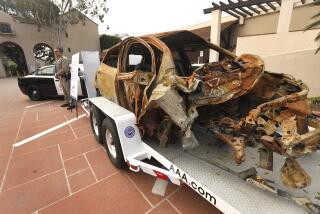The value of defensive driving: The driver next to you may be impaired [Updated]
- Share via
Reporting from Hollywood, Fla. -- Drunk or impaired drivers cause plenty of problems on the nation’s roadways. And, according to the first study of its kind, a frightening number of drivers are not fit to drive.
Researchers from the National Highway Traffic Safety Administration and two other institutions set out to randomly sample drivers’ sobriety in the 2007 U.S. National Roadside Survey. Authorities stopped drivers at 300 locations in 48 states during four periods on Friday and Saturday nights. At 60 of the locations, drivers were stopped during a day-time period. Blood samples were obtained from 3,276 drivers and saliva samples from 7,719. The samples were used to detect the presence of 75 different drugs.
Among daytime drivers, 11% were positive for drug use based on saliva tests. Six percent of daytime drivers tested positive for illegal substances. In contrast, 14.4% of nighttime drivers tested positive for drugs. Ten percent of drivers tested positive for illegal drugs.
Alcohol was found more than any other drug, with marijuana coming in second. And states that have legalized medical marijuana may have even higher rates of drivers under the influence of the drug. In a related analysis, 819 California drivers supplied saliva samples, which showed 8% of them were positive for marijuana. Most of the people who said they had medical-marijuana permits tested positive. More drivers with permits tested positive for marijuana than drivers without permits.
More studies should focus on the effects of marijuana use on driving, said the researchers, from the Pacific Institute for Research and Evaluation in Calverton, Md.
The next phase of the National Roadside Survey will look at the extent to which drug use is related to crashes.
The study was presented Tuesday at a meeting of the College on Problems of Drug Dependence.
In other news from the meeting:
- Drinking problems are known to occur more often in people who take their first alcoholic drink at a young age. Now researchers say it may be possible to spot someone who is on the path to alcohol dependence as early as six months after beginning to drink.
The study, by researchers at Michigan State University, used national survey data from the years of 2004 to 2007 and identified 4,876 people who said they had taken their first alcoholic drink in the prior 180 days. In some people, symptoms of alcohol dependence were already apparent. For example, one in six to seven people said they had already attempted to set limits to reduce the amount they were drinking. There was no difference between men and women in the rates of people who were showing signs of dependence.
The research is noteworthy because it suggests that it may be possible to spot problem drinking very early after the onset -- and perhaps before individuals begin to experience many of the repercussions of alcohol misuse.
“This work sets the stage for new research on these very early stages of alcohol involvement and problem-related drinking experiences,” the authors wrote.
- Ecstasy is a popular party drug that may leave its mark on the brain long after the party is over, according to new research.Studies in rats show Ecstasy, known as MDMA, causes the loss of serotonin axons. Researchers at Vanderbilt University studied 25 Ecstasy users who had not used the drug for at least 90 days. They were compared with 10 people who had never used the drug. The participants underwent PET scanning to assess changes to the 5-HT transmitters in the brain that are crucial for sustaining healthy levels of serotonin. The study found that former Ecstasy users exhibited the lost of 5-HT receptors, just as animal studies have shown.
Return to Booster Shots blog.
[For the record, 12:55 p.m. June 23: An earlier version ot this post left out a word in the title National Highway Traffic Safety Administration.]






